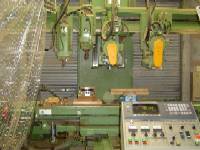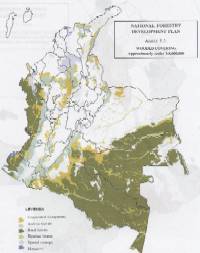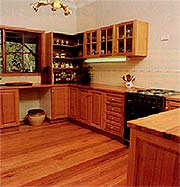Special Program for International Students
GRADUATE COURSE IN EARTH SCIENCE
& GEOENVIRONMENTAL SCIENCE
Current IDB students
Darnelly Obando Cruz (Colombia)
Email: s039513 @matsu.shimane-u.ac.jp,
darnelly_obando @yahoo.com
Thesis title: The Machinability of Sapan (Clathrotropis brunnea)
Supervisor: Prof. Chiaki Tanaka (2003-2005).
The natural forest of Colombia contains a variety of hardwoods that are used in the timber industry. In some cases the machining process for this species is inefficient and production costs are high. Machinability of a material is usually defined in terms of three factors, namely surface finish and integrity of the material part, tool life obtained, and force and power requirements.
Sapan (Clathrotropis brunnea) is a heavy wood with basic specific gravity averaging from 0.80 to 0.97. It is used for rail traverses, heavy construction, floors, decorative and heavy furniture, veneers, and the like. Nevertheless, its working properties are reported as being difficult to saw and difficult to dress using common carpentry machines.
The goal of this research is to study the machinability of this species, and to determine suitable cutting tool materials for its efficient processing, by evaluating the tool wear, cutting forces and surface roughness of the machining process. The results will contribute to improving the transformation process of the timber industries.
Spanish.
El Bosque Natural Colombiano contiene una variedad de maderas duras que son usadas en la industria forestal. En algunos casos el proceso de transformación de estas especies es ineficiente y tiene un elevado costo de producción. La trabajabilidad de un material generalmente es definida en términos de tres factores tales como la calidad de la superficie y la integridad del material obtenido, la duración de las herramientas empleadas, así como las fuerzas y los consumos de energía.
Sapan (Clathrotropis brunnea) es una madera dura con una densidad básica específica que varía de 0.80 a 0.97 utilizada para traviesas de ferrocarriles, construcción, pisos, muebles decorativos y pesados, chapas, etc. Sin embargo su trabajabilidad ha sido reportada como difícil de aserrar y de elaborar en las maquinas de carpintería comunes.
El objetivo de esta investigación es estudiar la trabajabilidad de esta especie y determinar materiales de herramientas adecuados para su eficiente transformación, así como determinar las fuerzas de corte y la superficie obtenida en el proceso de maquinado. Los resultados contribuirían con el mejoramiento de los procesos de transformación de las industrias forestales.




